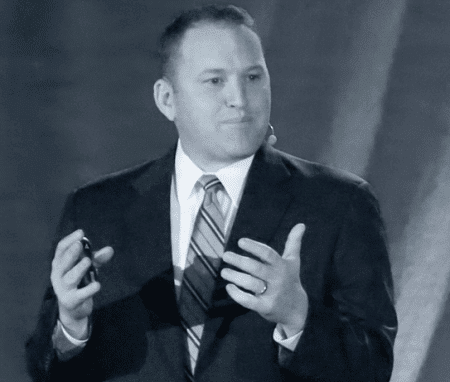Into the Darkness and Back Again: The Business Lessons I Learned From Landing on an Aircraft Carrier at Night
“The whole world steps aside for the man who knows where he is going.” – Anonymous
They call it “comfort time.” I am not sure who came up with that definition, but in my humble opinion, it was anything but comfortable.
You see, there is a time in every Marine fighter pilot’s life when he has to land on an aircraft carrier for the first time at night. Notice that I said “has to.” The first night landing is anything but a good deal.
It is just about the most dangerous thing that I can ever remember doing. However, as a carrier pilot in the United States Marine Corps, I am proud to be a citizen in the only country that lands its aircraft on a carrier at night — crazy as it may be.
For me, that first night landing started out on “Cat 1.” (The “cat” is the catapult mechanism designed to get your 45,000-pound airplane from 0 to 165 miles per hour in about 2 seconds.)
There I sat on Cat 1 with my knees shaking for what seemed like hours while waiting for the ground crew to finish its final checks on my aircraft.
When all the checks were complete, I ran the throttles to maximum power and gave a salute to the man who held my life in the balance with the catapult launch button.
He pushed the small green button that sent me propelling into the cloudy darkness off the San Diego coast.
My Adventure Had Begun
Some time, long ago, some Navy guy got the idea that it would be a solid idea to give pilots some extra time in the air in order to get comfortable before making their attempt at the carrier deck. Of course, what this guy failed to realize was that the entire time you are flying over a carrier, you are far from comfortable.
This guy probably got a medal while pilots everywhere spent 30 minutes in anxious anticipation of the inevitable, wondering, “Can we get this over with, please?!”
I spent my own comfort time trying to keep calm, cool, and collected, but of course I was a bundle of nerves.
It really was a beautiful night. The stars were out. The full moon was bright. Everything was quite nice. Well — almost everything. You see, starting at 700 feet above the water and ending at about 1,200 feet, there was a very thick cloud layer.
Normally, this layer would not be too much of a problem. I’d had hundreds of hours of training to teach me to fly through clouds just like this one. Only, on this particular night, the cloud layer would be the source of a significant problem for me.
As I lined myself up behind the USS John Stennis using the navigational aids in the F-18, I took one more look at the clouds.
“No problem,” I thought. “I’ve been here before; just a simple descent on my glide slope final course and I will be out of this cloud in no time.”
As I descended into the cloud layer 1,200 feet above the water, I was overcome with vertigo.
Let’s play make believe for a moment. Pretend that you are standing blindfolded in the middle of a room and someone spins you around about 20 times, then just stops you cold. That dizzy, disoriented feeling is vertigo.
Normally, vertigo is just uncomfortable, but in a high-performance fighter it can be deadly.
On that first carrier landing approach, my brain started to lie to me. I felt a gentle rolling sensation to the left telling me to move the stick to the right to correct the airplane.
But just as I was about to turn right, I took a look at my Heads-Up-Display, which is the instrument that tells a pilot whether he is climbing, descending, turning right, or turning left. My instruments revealed the impossible:
I was flying straight and level!
All the while it felt like I was tumbling out of control, in a death spiral to the left. My whole self was screaming, “Roll right! Roll right! You are going to crash!”
Just as I was about to turn the airplane to the right (which would have inevitably led to my death), I heard a small, still voice in the back of my head say,
“Trust your instruments.”
The argument in my head may have only lasted a few seconds, but it felt like a lifetime. The whole time, I was positive that I was about to crash into the water at any moment.
“So, this is how it ends?” I thought.
That night, I had to choose from the following: trust myself or trust my instruments; trust my instincts or trust my training.
Webster’s Dictionary defines vertigo as “a disordered state in which the individual or the individual’s surroundings seem to whirl dizzily; a dizzy, confused state of mind.”
I define it as the condition that nearly killed me.
Webster’s defines training as “forming by instruction, discipline, or drill; to teach so as to make fit, qualified, or proficient.”
I define it as the discipline that saved my life.
I listened to my training that night, and it made all the difference in the world. I landed successfully aboard the USS Stennis and rolled out of the landing area. My legs were shaking uncontrollably.
So much for being as cool as Iceman, huh?
I would like to tell you that the reason I am alive today is due to my quick thinking, my superior piloting skills, and my above-average intellect. I’d love to take credit for the work that I did that night and to pat myself on the back.
I cannot do that.
I must give credit where credit is due. I have a legacy to thank — over 100 years of aviation excellence passed from pilot to pilot, from instructor to student, until it reached me, when my own instructor said, “Ed, when all else fails, trust your instruments.”
For those of us who must make life-changing decisions, I am fully convinced that the quality of those decisions is determined well before the day the decisions are made.
The decisions you will make tomorrow are based on the habits and the experience you have built throughout your life. In short, what you decide will be a function of who you are; and who you are will be a function of your training.
What decisions have you made this week?
 Perhaps millions of dollars rested on a decision you made, or perhaps it was simply the dinner selection for your hungry children. In either case, you have been disciplined to make decisions based on your training, however formal or informal that training may have been.
Perhaps millions of dollars rested on a decision you made, or perhaps it was simply the dinner selection for your hungry children. In either case, you have been disciplined to make decisions based on your training, however formal or informal that training may have been.
The key, then, becomes molding and shaping your influences to mold and shape you. My fate was finalized that night behind the carrier, but it wasn’t decided then.
My fate had been decided months before when I spent hours flying a simulated airplane through simulated clouds onto a simulated carrier. My training saved my life that night.
So — how is YOUR training?
If you often feel overwhelmed by the challenges you face daily, let me encourage you to take time every day to train yourself. You can start with reading. I cannot remember a day in recent history when I did not spend some time reading. I personally read at least one book a week, and sometimes as many as four.
I personally start just about every day with 30 minutes of Bible reading, prayer, and meditation. I can’t think of a better way to start a day. If you want to align every area of your life, start there.
But don’t stop there. Read biographies of successful people, read success literature, read inspirational books. You should read fiction too: It keeps your mind active and clears your head of the world for awhile.
Listen to audios and podcasts from seminars or trainings that apply to your work or passion. I download about 4 to 5 hours of material into my iPhone at the beginning of the week. Then I listen as I am working out, doing the dishes, driving to the post office, etc.
The number of ways to train yourself for success is endless.
The time to start is right now.
Interested in learning more about how being a fighter pilot taught me valuable business lessons? Download a FREE Copy of my book!
About The Author

Ed Rush is a world-renown speaker, a five-time #1 bestselling author, and a highly successful business consultant who was featured on CBS, Fox, ABC, and NBC. He has spent a significant amount of time in the cockpit of an F-18 fighter jet, so he knows the value of strategy and the power of focus. He has effectively taken the principles that he learned flying faster than the speed of sound, and translated them into good business. His clients range from small startups to multinational organizations, and include CEOs, founders, political leaders, sports teams, national universities, Hollywood stars, and even a contestant on Donald Trump’s The Apprentice. To buy any of Ed's books, visit his bookstore right now or hire Ed to speak at your next event.

